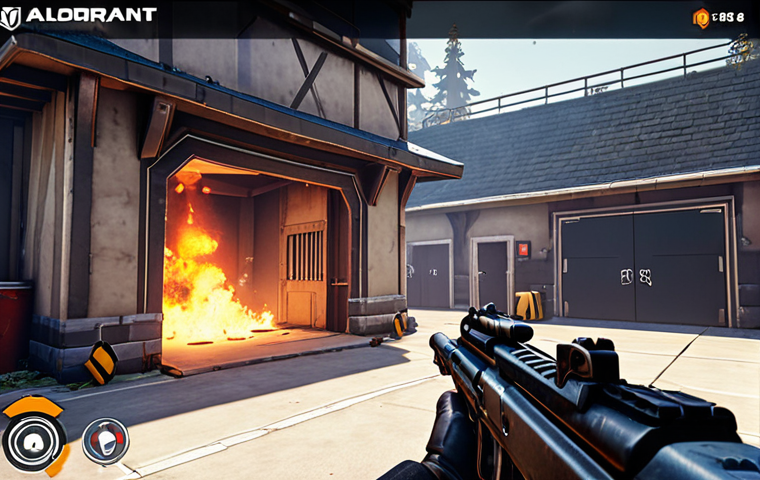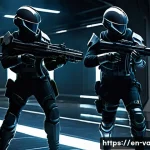Alright, let’s dive into some Valorant strategy! Valorant, the tactical shooter sensation, isn’t just about raw aim. Knowing the maps and, more importantly, the *best* spots on those maps can give you a serious edge.
After spending countless hours playing, I’ve noticed that controlling key areas often dictates the flow of a match. A well-placed player can lock down an entire bombsite or provide crucial support for their team.
With the constant updates and meta shifts in Valorant, these power positions evolve, making it critical to stay informed. The rise of new agents and weapon balances have particularly influenced which spots are most effective.
In today’s strategic landscape, mastering these advantageous locations is more important than ever. Let’s get this breakdown started so you can learn it too!
Controlling Ascent’s Mid-Lane: A Key to Victory

Ascent’s mid-lane is a crucial chokepoint that heavily influences the game’s tempo. The team that controls mid often has the freedom to rotate quickly between bomb sites, apply pressure, and gather information.
Mastering this area requires understanding the common angles and positions where enemies might be lurking.
Holding the High Ground: Top Mid Control
Holding top mid offers a significant advantage, providing sightlines into both A and B main. Agents with mobility abilities, such as Jett, can use this position to quickly reposition and catch opponents off guard.
From my experience, using a sniper rifle like the Operator from this vantage point can yield early picks and deter pushes, especially when combined with a sentinel agent providing cover.
Lurking in Mid Link: The Element of Surprise
Mid link, connecting mid to the attacker’s spawn, is a prime spot for lurkers. Players can quietly rotate into this position to flank unsuspecting enemies or provide backup to teammates pushing into mid.
I’ve found that patience is key here; waiting for the right moment to strike can disrupt the enemy’s formation and create opportunities for your team.
Defensive Strongholds on Bind: Securing B Site
Bind’s B site is a tight, enclosed space that favors close-quarters combat. Defenders must utilize utility and clever positioning to hold this site against coordinated pushes.
After playing hundreds of rounds on Bind, it’s clear to me that controlling B site hinges on denying entry and punishing aggressive plays.
The Back Site Corner: A Classic Defender’s Haven
The corner at the back of B site is a classic defensive position. From here, players can hold a tight angle on the entrance and react quickly to incoming threats.
I’ve often used this spot to bait out enemy utility and secure easy kills when they push in expecting an empty corner.
Window Watch: A Risky but Rewarding Angle
Holding the window overlooking B site is a risky but rewarding strategy. This position provides excellent visibility of the site entrance, but it also leaves you vulnerable to being flanked or caught by surprise.
A well-placed smoke grenade can mitigate some of the risk, allowing you to peek and reposition safely.
Haven’s Garage Control: A Game-Changer
On Haven, securing garage control is paramount. It offers attackers a direct route to C site and a crucial flank for A site pushes. Teams that consistently win the garage fight often dictate the pace of the game.
Aggressive Garage Push: Catching Defenders Off Guard
An aggressive garage push can catch defenders off guard, especially if they are expecting a slow, methodical approach. Using flashbangs and entry fraggers can quickly clear out the garage and create space for your team to advance.
From my countless matches on Haven, I’ve found that coordinating this push with a simultaneous attack on another site can overwhelm the defense.
Defensive Garage Hold: Denying Entry with Utility
Defenders can effectively hold the garage by utilizing utility to deny entry and slow down the attackers’ advance. A well-placed Killjoy turret or Cypher cage can provide early warning of an incoming push, allowing your team to prepare for the engagement.
I’ve seen teams successfully hold the garage by using a combination of smokes, molotovs, and well-timed peeks.
Split’s Mid Control: Dictating the Map’s Flow
Split’s mid area is a battleground for map control, offering pathways to both A and B sites. The team that controls mid often has the flexibility to rotate quickly, apply pressure, and outmaneuver the enemy.
Mastering Split’s mid requires understanding the common angles and anticipating enemy movements.
Rope Access: A Quick Route for Aggressors
The rope access on Split’s mid provides a quick route for attackers to gain high ground and surprise defenders. A coordinated push through rope can disrupt the enemy’s formation and create opportunities for your team to advance.
In my experience, timing this push with a simultaneous attack on another site can overwhelm the defense and secure a bomb plant.
Mid Vent Lurk: The Silent Assassin’s Path
The mid vent offers a sneaky pathway for lurkers to flank unsuspecting enemies or provide backup to teammates pushing into mid. This position requires patience and awareness, as you must anticipate enemy movements and react accordingly.
I’ve found that waiting for the right moment to strike can disrupt the enemy’s defense and create openings for your team.
Icebox’s A Site Defense: The Power of Verticality
Icebox’s A site is characterized by its verticality, offering defenders numerous vantage points to hold against attackers. Successfully defending A site requires utilizing these vertical angles and denying entry to the attackers.
Rafters Hold: The Overlook Advantage
Holding the rafters above A site provides defenders with a clear line of sight over the entire area. This position allows you to spot incoming attackers and react quickly to their movements.
However, it also leaves you vulnerable to being flanked or caught by surprise. I’ve often used this spot to provide cover for teammates pushing into the site and secure easy kills on unsuspecting enemies.
Nest Control: The Hidden Defender
The Nest position offers a more concealed defensive angle on A site. From here, players can hold a tight angle on the entrance and surprise attackers who are pushing into the site.
I’ve found that using a shotgun or SMG in this position can be particularly effective, as it allows you to quickly eliminate enemies at close range. Here’s a table summarizing effective agent usage on certain maps:
| Map | Agent | Reason |
|---|---|---|
| Ascent | Jett | Mobility for aggressive plays in mid. |
| Bind | Brimstone | Smokes and molotovs to control tight spaces on B site. |
| Haven | Killjoy | Turrets and nanoswarms for locking down garage. |
| Split | Cypher | Cages for slowing pushes through mid and on bomb sites. |
| Icebox | Viper | Walls and poisons for controlling chokepoints on A and B. |
Sunset’s Strategic Control Points
Sunset, with its intricate layout, demands a nuanced understanding of key control points. These locations often dictate the pace of engagements and provide crucial advantages for either attacking or defending teams.
Market Window Dominance
The Market Window provides a high-ground vantage point that overlooks critical areas such as mid and B main. Holding this position allows players to gather valuable information about enemy movements and apply pressure from a safe distance.
Courtyard Chokepoint
Courtyard serves as a central chokepoint that connects various pathways on the map. Controlling Courtyard enables teams to quickly rotate between sites and exert influence over a wider area.
Breeze’s Open-Air Domination
Breeze, with its open spaces and long sightlines, requires a unique approach to map control. Securing key areas and utilizing utility effectively are essential for success on this map.
Mid Cannon Control
Controlling Mid Cannon grants teams access to a powerful positional advantage, allowing them to oversee both A and B sites. The elevated position provides a clear line of sight and enables swift rotations.
Cave Lurk Potential
The Cave offers an excellent opportunity for lurking and flanking maneuvers. Players can quietly position themselves within the Cave to surprise unsuspecting enemies and disrupt their formations.
Controlling these key areas on each map is essential for maximizing your team’s chances of success in Valorant. Whether you’re holding down a site on defense or pushing aggressively on offense, understanding the nuances of each map and the strengths of different agents can give you a competitive edge.
Remember, communication and coordination are key to executing these strategies effectively. So, gather your team, practice these tactics, and dominate the Valorant battlefield!
Wrapping Up
Ultimately, mastering Valorant’s maps boils down to understanding the interplay between agent abilities, map layouts, and team coordination. My personal experience shows that the team that adapts best to the ever-changing flow of the game, while leveraging these strategic points, is the one that usually comes out on top. Don’t be afraid to experiment with different agents and strategies to find what works best for you and your squad. Good luck out there, and may your aim be true!
Useful Tips and Tricks
1. Utilize Smokes Strategically: Smoke grenades are crucial for denying vision and controlling entry points. Learn the common smoke spots on each map to effectively block off enemy sightlines.
2. Master Crosshair Placement: Proper crosshair placement can significantly improve your reaction time and accuracy. Aim at head level around corners and common engagement spots.
3. Communicate Effectively: Communication is key to coordinating attacks, defending sites, and sharing information about enemy positions. Use voice comms to relay important updates to your team.
4. Learn Economy Management: Understanding Valorant’s economy system is essential for making informed decisions about weapon purchases and ability usage. Coordinate with your team to maximize your collective buying power.
5. Adapt to Enemy Playstyles: Pay attention to the enemy team’s tendencies and adjust your strategies accordingly. If they are consistently pushing a certain site, rotate your defenses to counter their aggression.
Key Takeaways
Effective map control in Valorant requires a combination of understanding agent strengths, exploiting map layouts, and coordinating with your team. By mastering these elements, you can gain a significant advantage over your opponents and increase your chances of victory. Remember to adapt your strategies based on the map, agent composition, and enemy playstyle to maximize your effectiveness on the battlefield. Good luck, and have fun climbing the ranks!
Frequently Asked Questions (FAQ) 📖
Q: How often do Valorant map strategies need to be updated to stay effective?
A: Honestly, it feels like constantly! With new agents dropping, weapon tweaks, and map changes, strategies can become obsolete pretty quickly. I’d say at least once a patch or even more frequently depending on how much the meta shifts.
Staying on top of pro matches and patch notes is crucial. It’s like, one week a certain angle is amazing, and the next week everyone knows about it and you’re just an easy target.
Q: Besides watching professional matches, what’s another good way to discover new or underutilized power positions on Valorant maps?
A: I’ve found that watching streamers and YouTubers who focus on specific agents or roles is super helpful. They often experiment with unconventional spots and find clever ways to use agent abilities to control areas.
Also, just playing a lot and trying different things yourself! I’ve stumbled upon some surprisingly effective positions just by messing around in custom games with friends.
Don’t be afraid to be a bit unorthodox; sometimes the best spots are the ones nobody expects. I was playing a game on Bind and no one expected me to boost on top of boxes in B site with Jett, I got 3 easy kills!
Q: How important is team communication when utilizing specific power positions in Valorant?
A: Dude, it’s absolutely vital. Holding a power position isn’t just about getting kills; it’s about providing information to your team. If you’re watching a flank, you need to call out enemy rotations.
If you’re holding down a bombsite entrance, you need to let your team know when you’re getting pressured. A silent sentry is a useless sentry. Plus, coordinating with your teammates on utility usage (smokes, flashes, etc.) can make holding those positions way easier.
I hate to say it, but someone with great aim and zero comms is going to struggle.
📚 References
Wikipedia Encyclopedia
구글 검색 결과
구글 검색 결과
구글 검색 결과
구글 검색 결과
구글 검색 결과






